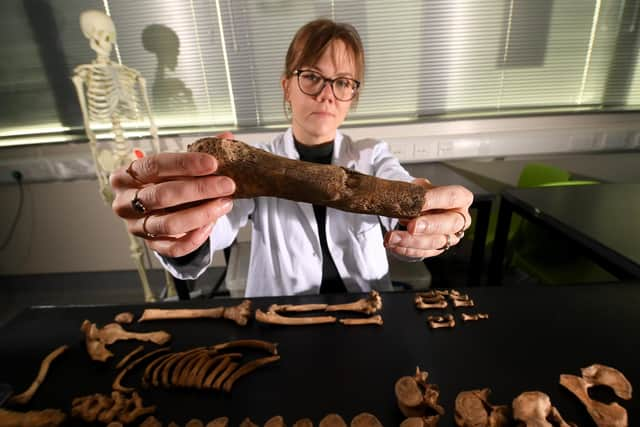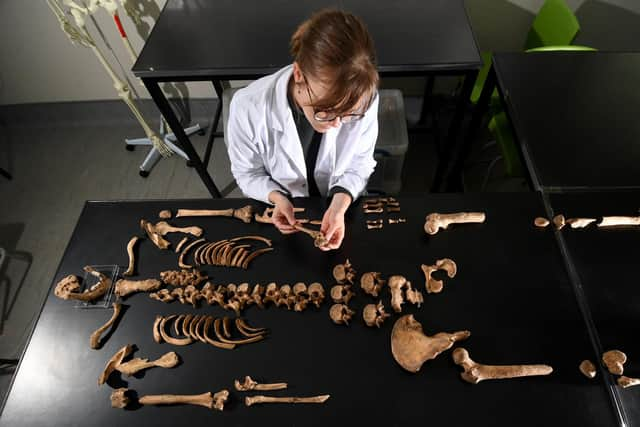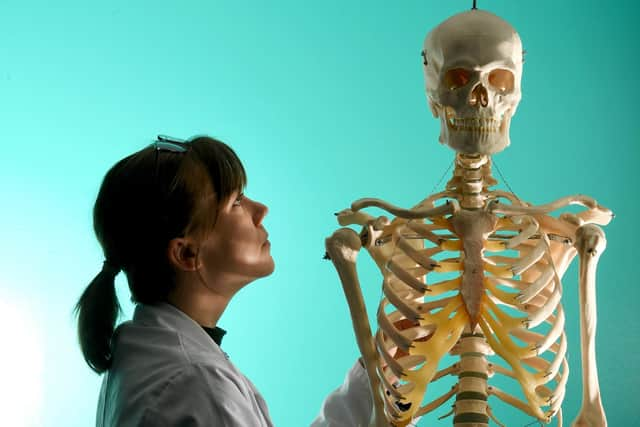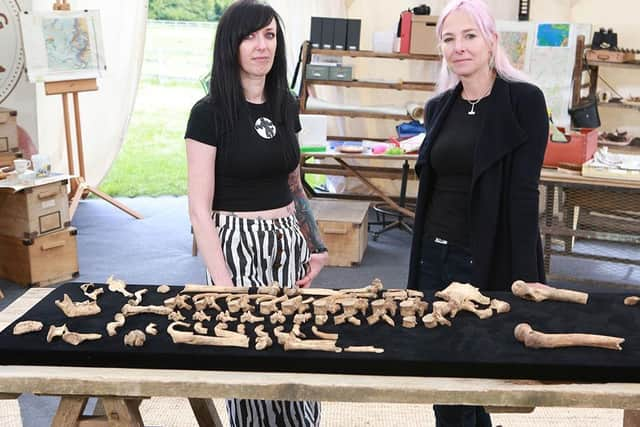The mystery of the medieval skeleton believed to be a lady anchoress of York Barbican
Subsequent analysis of the bones carried out by researchers at the University of Sheffield and Oxford Archaeology Limited, has revealed this particular skeleton is almost certainly that of Lady Isabel German, an important anchoress – a type of religious hermit – who is documented to have lived at All Saints Church in Fishergate, during the 15th century.
Anchoresses were different from nuns. They lived as a recluse in a parish church and would have volunteered for the role and needed permission from the local bishop.
Advertisement
Hide AdAdvertisement
Hide AdDuring the 14th and 15th centuries there were more than 200 anchoresses in England – in York alone there were another seven at the same time that Lady Isobel German was alive.


The collection and the investigation into Lady German featured on BBC Two’s popular Digging For Britain programme, which is available on iPlayer in which Professor Alice Roberts follows a year of British archaeology, joining up the results of digs and investigations the length of the country.
Dr Lauren McIntyre, a former University of Sheffield student and now an Osteoarchaeologist at Oxford Archaeology, worked on both the excavation and the skeleton analysis and with the help of radiocarbon dating and isotopic analysis has been able to lift the veil on her story.
“This burial was inside All Saints Church which is unusual for the medieval period because it’s normally only clergy or rich people who were buried inside a church. It was thought the closer you were buried to the high altar the closer you were to God,” she says.
Advertisement
Hide AdAdvertisement
Hide AdAnother unusual feature was the body’s position – tightly crouched with the knees up near the face. “When I looked at the bones you could see she had quite a lot of disease and she would have been quite ill at the end of her life. She probably had septic arthritis, she also had osteoporosis and most notably there is evidence of venereal syphilis.”


The picture gleaned is not a pretty one – by the time the woman died her joints were riddled with disease and she would have had open sores all over her body.
Identifying who she was took a fair bit of detective work.
There is evidence that an anchoress had been living at the church and Lady Isabel German is named in several wills, so it’s known she lived there from at least 1428 until 1455.
“We can’t prove it definitively, but we know her name and we know roughly the time she was living at the church, so there’s a pretty strong case for saying this skeleton is her,” says Dr McIntyre.


Advertisement
Hide AdAdvertisement
Hide AdYou might assume that Lady German’s life was a desperate one and certainly in the medieval period there was an association between diseases that cause disfigurement and sin – the idea that you’re sent this horrible condition as a punishment from God.
However, Dr McIntyre has another theory.
“While it is very tempting to suggest that someone with visible disfiguring disease would be shunned or want to commit to living as an anchoress as a way of hiding from the world, this research has shown that this might not be the case. Such severe disease could also have been viewed positively, as being sent by God to grant martyr-like status to someone special,” she says.
There were more than 200 anchoresses in England during this period and at a time when women would realistically have been expected to get married and become the property of their husband, it offered them the chance of an alternative life.“The new study data allows us to explore the possibilities that Lady German chose to devote herself to a life of solitude as a way to remain autonomous and in control of her own destiny. This chosen lifestyle would also have made her a highly significant figure within the local community, and she would have been viewed almost like a living prophet,” says Dr McIntyre.


“I really like the fact we’ve been able to tell the story of a medieval woman. When you read a lot of historical documents they’re usually written about men, so it’s great that we’re able to talk about a woman and have a fair idea about what was going on in her life. She had some privacy, she had some agency and she had a say in what was going to happen to her, even if it might seem like quite an extreme thing to do.”
Advertisement
Hide AdAdvertisement
Hide AdLady German’s remains and the York Barbican collection are part of a wider collection of more than 3,000 skeletons, from around 15 archaeological sites across the country, housed at the University of Sheffield.
This ever expanding skeletal collection is one of the largest in the UK and an invaluable learning resource for the university’s post-graduate researchers as well as visiting archaeologists who travel from as far away as Australia, Canada and the US to study these precious bones.
Dr Lizzy Craig-Atkins, senior lecturer in human osteology at the University of Sheffield, says bones hold a wealth of information – they can tell us the diseases a person had and shed light on everything from their diet to where they came from.
“You are what you eat and the isotopic composition of the different foods you consume create your bone tissue, so it’s all there in your bones.”
Advertisement
Hide AdAdvertisement
Hide AdThe skeletons are used by the students to carry out cutting-edge research in osteology.
“We prioritise working with real human remains in our archaeological training because they are the skills that students need when they actually become archaeologists working in museums,” says Dr Craig-Atkins.
The collection, which has been accrued over the past 30 years, focuses on the Roman period through to the 19th century. “We have large collections from the early medieval period, particularly from the North of England, which was a really interesting time because the transition to Christianity in the North takes quite a different course compared to the South where you have these really highly furnished pagan cemeteries. In the North there was much more Celtic influence.”
They also have important skeletal collections from the period of the Industrial Revolution. “They’re important because they tell us about the process of industrialisation and the impact of industrial life on people’s bodies. When people moved to big cities with high levels of urban pollution, doing heavy manual labour in a largely unregulated economy, it had an impact on their health in terms of injuries and disease and you see that in the skeletons.”
Advertisement
Hide AdAdvertisement
Hide AdDr Craig-Atkins believes collections like this are crucial in improving our knowledge of the past. “There’s real importance in understanding who we are and where we’ve come from, and the human skeleton is the most tangible link to people and the past that you could possibly hope for. “As an archaeologist and a historian you’re actually able to study the remains of someone’s body and the body is so important to archaeology because it responds to the environment that you live in. Your bones react to your health, your activity, your diet and the diseases you suffer during your life," adds Dr Craig-Atkins. "So the skeleton is like a little archive of things that have happened to you and because that archive is durable it allows us to look back in time and still capture that information so we can tell the stories of people that lived in the past.”
Digging For Britain is available on BBC iPlayer.